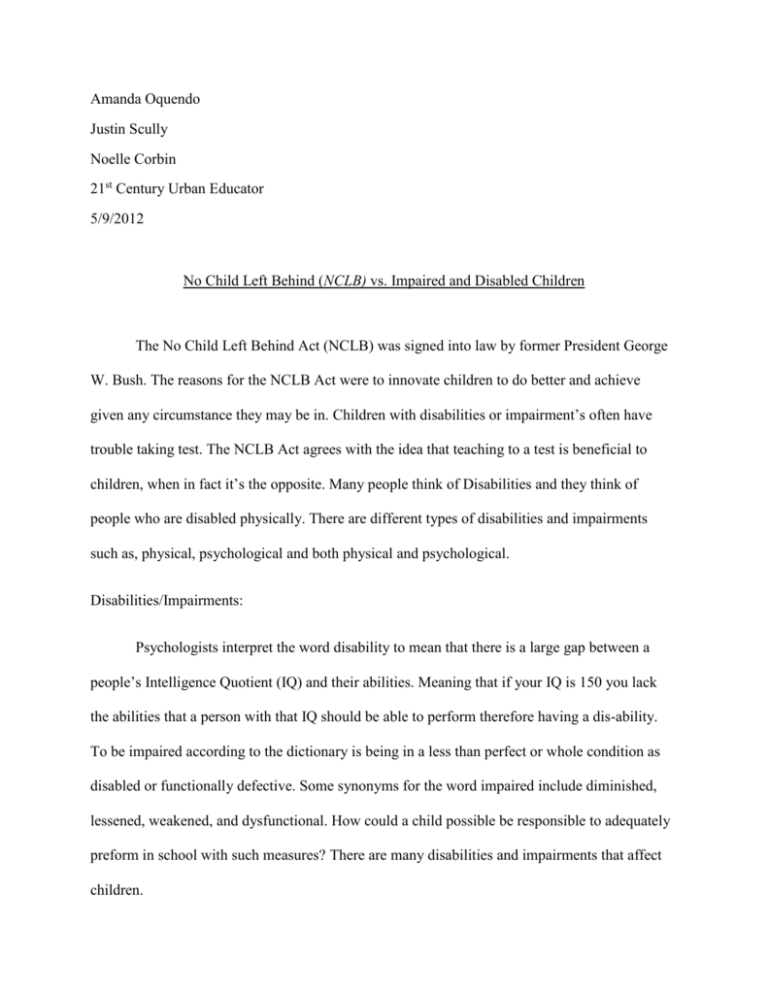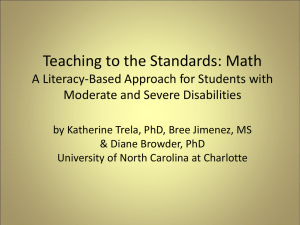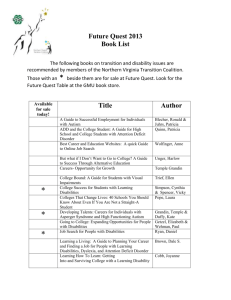21st Urban Educator_Group
advertisement

Amanda Oquendo Justin Scully Noelle Corbin 21st Century Urban Educator 5/9/2012 No Child Left Behind (NCLB) vs. Impaired and Disabled Children The No Child Left Behind Act (NCLB) was signed into law by former President George W. Bush. The reasons for the NCLB Act were to innovate children to do better and achieve given any circumstance they may be in. Children with disabilities or impairment’s often have trouble taking test. The NCLB Act agrees with the idea that teaching to a test is beneficial to children, when in fact it’s the opposite. Many people think of Disabilities and they think of people who are disabled physically. There are different types of disabilities and impairments such as, physical, psychological and both physical and psychological. Disabilities/Impairments: Psychologists interpret the word disability to mean that there is a large gap between a people’s Intelligence Quotient (IQ) and their abilities. Meaning that if your IQ is 150 you lack the abilities that a person with that IQ should be able to perform therefore having a dis-ability. To be impaired according to the dictionary is being in a less than perfect or whole condition as disabled or functionally defective. Some synonyms for the word impaired include diminished, lessened, weakened, and dysfunctional. How could a child possible be responsible to adequately preform in school with such measures? There are many disabilities and impairments that affect children. A psychological disability is something like ADD, attention defecate disorder, ADHD, attention and hyper active disorder, Autism etc. a type of physical disorder is something like being hearing impaired or visually impaired , anything that can deals with the outer body. Then you have a category of children/adults who have a combination of both physical disabilities as well as mental impairments. “Autism has increased at an unprecedented rate in recent years. The U.S. Centers for Disease Control (Centers for Disease Control [CDC], (2007) reported in a prevalence study of autism that one in 150 8-yearolds have been identified with the disorder. The 2005 U.S. Government Accountability Office (U.S. GAO, 2005) Report to the House of Representatives on Special Education reported a 500% increase in the number of students aged six to 21 identified with autism in the past 10 years”(Moores-Abdool). There is an increasing rate of students that are being born with learning disabilities such as Autism every day; don’t they deserve the same education as any other child? “Because of variability in manifestations of their disability, students with autism need curriculum modifications or instructional accommodations to access the general curriculum” (Moores-Abdool). These children need extra care that is not being efficiently provided to them. A child who is hearing impaired would most likely go to a school or the deaf, but what about those kids who still have the ability to hear but just not as good as the other children? “NCLB began with the goal of 100% of students reaching proficiency in all content areas by 2014. Over the past several years of school report cards, schools for students who are deaf or hard of hearing have shown very little progress toward meeting those goals”(Cawthon). Just because an Act is put into effect and a child goes to an efficient school doesn’t mean they don’t struggle. “However, given the fact that fresh cohorts of students are continually enrolling in schools, is it ever realistic to expect all students in a school to be 100% proficient? Even if 20 years were given to reach this goal, it still might not be feasible for a school to ensure that even students who had just enrolled would be able to meet grade level benchmarks” (Cawthon). Vision vs. Reality: There’s a clear point that the NCLB Act hasn’t really been effective. Their vision is to close the achievement gap, promote rigorous accountability, and ensure that all students are on track to graduate high school, then college, and are career-ready. The reality is that children are not improving and the gap in expanding and graduation rates have not been up to par. “Put simply, the adequate yearly progress, AYP provision of NCLB requires school districts to demonstrate each year that students with disabilities are making progress toward proficiency in the general curriculum. The goal is laudable: ensuring that such students catch up with all other students within twelve years. As momentous as that promise seems, though, the structure of NCLB's mandated performance will likely force school accountability systems to subject students to unreasonable high-stakes threats-e.g., having to pass an exam to move from one grade to the next or to earn a high school diploma”(Allbritten). There is the vision that “all” students, all includes disabled children, will be equally taught and lead a successful future. There are schools that are really good schools that offer many advantages for children but, they don’t offer any of the things that a disabled child may need like an IEP, Individual Education Plan. “Therefore, NCLB expects students with disabilities to graduate within 4 years of entering high school; IDEA permits students with disabilities to receive services in high school through age 21. The reason for this discrepancy of expectations has to do with the different foundational intentions of the two pieces of legislation. IDEA serves students with disabilities through the provision of individualized services. NCLB, in contrast, serves all students by holding schools accountable for student performance. These different policy mechanisms generate differing expectations for the graduation of students with disabilities”(Schifter). NCLB lacks a certain personal bond that the IDEA Act, The Individuals with Disabilities Education, provides. References: Allbritten, D. (2004). Will Students with Disabilities Be Scapegoats for School Failures?. . NCLB: Failed School- or Failed Laws?, 82(02), 153-160 Brohpy, J. (2004). Motivating students to learn (2nd ed.). Mahwah, NJ: Lawrence Erlbaum Associates. Cawthon, S.W. (2011). Education of Deaf and Hard hearing students and Accountability Reform: Issues for the Future. American Annals Of The Deaf, 156(4), 424-430. Daniels, P.R. (1983). Teaching the gifted/learning disabled child. Rockville, MD: Aspen Systems Horn, E., & Kang, J. (2012). Supporting young children with multiple disabilities: What do we know and what do we still need to learn? Topics in Early Childhood Special Education, 31(4), 241-248. Hyun-Jeong; Kingston, N. (n.d). Capturing Implicit Policy From NCLB Test Type Assignments of Students With Disabilities. Exceptional Children, 78(1), 58-72 Kauffman, James M.. (2011). Handbook of Special Education. New York: Routledge. Meir, D., Kohn, A., Darling-Hammond, L., Sizer, T.R.. Wood, George. (2004). Many Children Left Behind: How the No Child Left Behind Act Is Damaging Our Children and Our Schools. Boston: Beacon press. Moores-Abdool, W. (2010). Included Students with Autism and Access to General Curriculum: What Is Being Provided?. Issues In Teacher Education, 19(2), 153-169 Mores, T.E. (2001). Designing appropriate curriculum for special education students in urban schools. Education and Urban Society,34(1), 4-17. Parrish, P. R., & Stodden, R. A. (2009). Aligning assessment and instruction with state standards for children with significant disabilities. Teaching Exceptional Children, 41(4), 46-56. Schifter, L. (2011). High School Graduation of Students With Disabilities: How Long Does It Take?. Exceptional Children, 77(4), 409-422. Sunderman, Gail L.. Kim, James S.. Orfield, Gary. (2005). NCLB Meets School Realities: Lessons From the Field. Thousand Oaks: Corwin Press Winter, Sid. (2011). Positive Discipline: -101- A Guide to Teaching the Hard-to-Reach Students. Margate: ComteQ.








